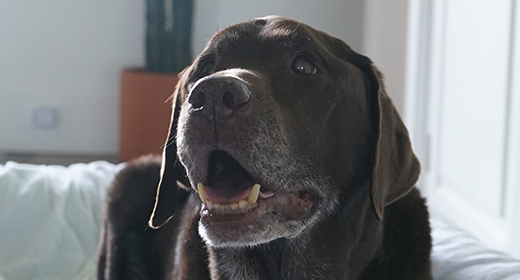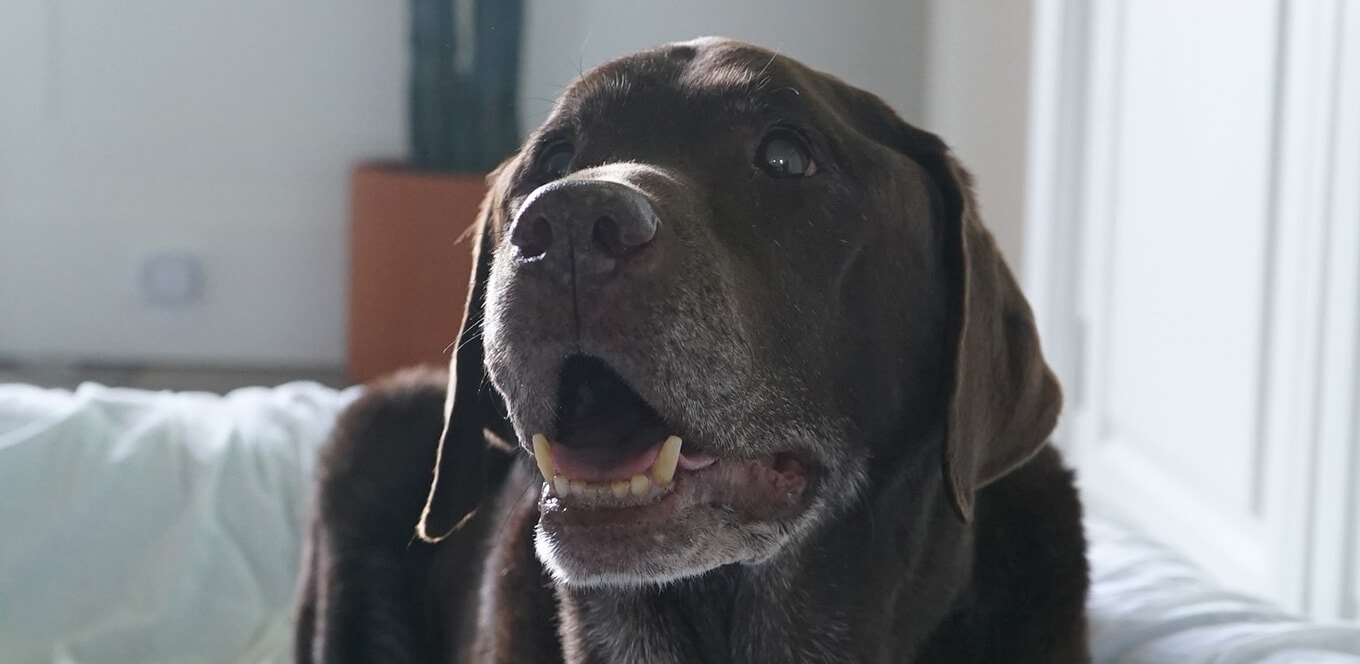

In the past, veterinarians recommended diets for senior dogs largely based on the nutritional management of diseases common to the aging process. Research, however, has shown that special nutrition can help manage body-condition problems in aging dogs, such as obesity and loss of muscle mass. Senior dogs also benefit from special nutrition to help maintain bone and joint health.
Learn more about how you can help your senior dog manage common health issues associated with aging.
Senior dogs tend to gain weight, despite consuming fewer calories, due to changes in their metabolic rate. Therefore, they can benefit from eating a diet with reduced fat levels and lower caloric density than adult maintenance foods.
Recent IAMS™ research in dogs also indicates that L-carnitine — a vitamin-like compound made in the body from the amino acids found in red meats, fish, chicken and milk — can help reduce weight in overweight dogs by escorting fat into cellular mitochondria where it is turned into energy.
Protein is the building block of muscle tissues. It is important for maintenance of muscle tissues, muscle strength and mobility. Recent research conducted by The IAMS Company has shown that senior dogs that eat a higher-protein diet better maintain muscle protein stores. By providing optimal protein levels from muscle maintenance, we can help senior dogs continue being physically active.
This research is contrary to conventional opinion that senior dog foods should contain lower protein levels than adult maintenance formulas to avoid progressive decrease in kidney function. However, senior dogs fed a high-protein diet had stable renal function and a lower death rate than dogs fed a lower-protein diet.*
During the aging process, cartilage between joints often begins deteriorating. Nutritional management can help maintain healthy bones and joints and mobility in dogs in several ways:
Some pet-food manufacturers have endorsed reduced levels of calcium and phosphorus based on the belief that excesses of these minerals are harmful to the kidneys. However, research has shown that no damaging accumulation of calcium or phosphorus was found in the kidneys of older dogs fed diets containing maintenance levels of calcium and phosphorus for four years.*
* Finco, DR. “Effects of aging and dietary protein intake of uninephrectomized geriatric dogs.” American Journal of Veterinary Research; Vol. 55, No. 9. Sept. 1994.



Deworming is the process of eliminating worms from the body, and it's an essential part of caring for your furry friend. Whether your puppy has already been diagnosed with worms or you simply want to take preventative measures, understanding how to deworm a puppy is crucial for their health and well-being.
But what exactly are worms, and how do puppies get them? Many types of worms can infect dogs, including roundworms, hookworms, whipworms, and tapeworms. These parasites are usually transmitted through contaminated soil, water, or food, and they can cause serious health problems if left untreated.
As a responsible pet parent, it's imperative to understand the process of deworming and how to keep your puppy safe and healthy. This blog will cover everything you need to know about deworming puppies, including the symptoms to look out for and the best ways to deworm your furry friend. Whether you are a new puppy parent or just looking to refresh your knowledge, this blog will provide the information you need to keep your pawfect pal worm-free.
Deworming your new pup is an indispensable part of adopting a dog. However, navigating the various deworming options and methods can be overwhelming. Here, we will uncover 4 must-knows to successfully deworming your puppy, including how often your puppy needs to be dewormed, the most effective treatment methods, and the importance of prevention. By understanding these key factors, you can ensure that your puppy remains happy and healthy, free from the discomfort and potential health risks caused by worms.
It's important to understand the importance of deworming your furry friend. This helps prevent the spread of worms and parasites, which can harm their health. Puppies need to be dewormed often due to their small size and underdeveloped immune systems.
According to experts, puppies should be dewormed every 2 weeks until 3 months of age and then every month until they are 6 months old. This helps to ensure that the worms are effectively eliminated from their system. It's also important to deworm pregnant dogs as they can pass worms on to their puppies in utero.
Along with deworming at regular intervals, good hygiene is essential to guarding against the spread of worms. Make sure you wash your hands after touching or playing with your puppy and clean up their waste immediately.
Overall, deworming is a crucial part of keeping your puppy healthy. Following a regular puppy deworming schedule and practising good hygiene can help protect your furry friend from harmful parasites.
Several worms can infect puppies, including roundworms, hookworms, whipworms, and tapeworms. These worms can cause various symptoms in puppies, including diarrhoea, vomiting, weight loss, and anaemia. It is important to deworm puppies regularly to prevent these worms from causing serious health problems.
Even if worms are not visible on your puppy, it does not mean they are not present. Some worms, such as tapeworms, can be challenging to detect because they are small and often pass through the stool in small pieces. Additionally, some worms can be present in the intestine without causing visible symptoms. Hence, follow a regular puppy deworming schedule and ensure that this four-legged angel is protected against these worms.
Worms in puppies can have many symptoms that can be difficult to spot, especially in young and small dogs. Common symptoms of worms in puppies include:
Deworming is especially important for puppies born to mothers who have worms, as they can be infected even before their birth. Following a proper deworming schedule and keeping an eye out for these symptoms can help keep your puppy healthy and happy. If you suspect your puppy has worms, it's important to take them to a veterinarian for treatment.
Worms are a common problem in puppies and can cause serious health issues if left untreated. The most common types of worms affecting puppies include roundworms, hookworms, and tapeworms. Symptoms of a worm infestation may include vomiting, diarrhoea, weight loss, and a pot-bellied appearance.
The good news is that worms are easily preventable and treatable in puppies. It's important to get your puppy on a regular deworming schedule, as recommended by your veterinarian. This will typically involve giving your puppy a deworming medication every few weeks until they reach a certain age. In addition, keeping your puppy's environment clean and preventing them from ingesting potentially contaminated objects can help prevent worms.
Suppose your puppy does end up with worms. In that case, your veterinarian will likely prescribe a deworming medication that can be given orally or through injection. It's important to follow the recommended treatment plan and continue the treatment for the entire prescribed course to ensure all the worms are eliminated.
Overall, it's important to be proactive in preventing and treating worms in puppies.